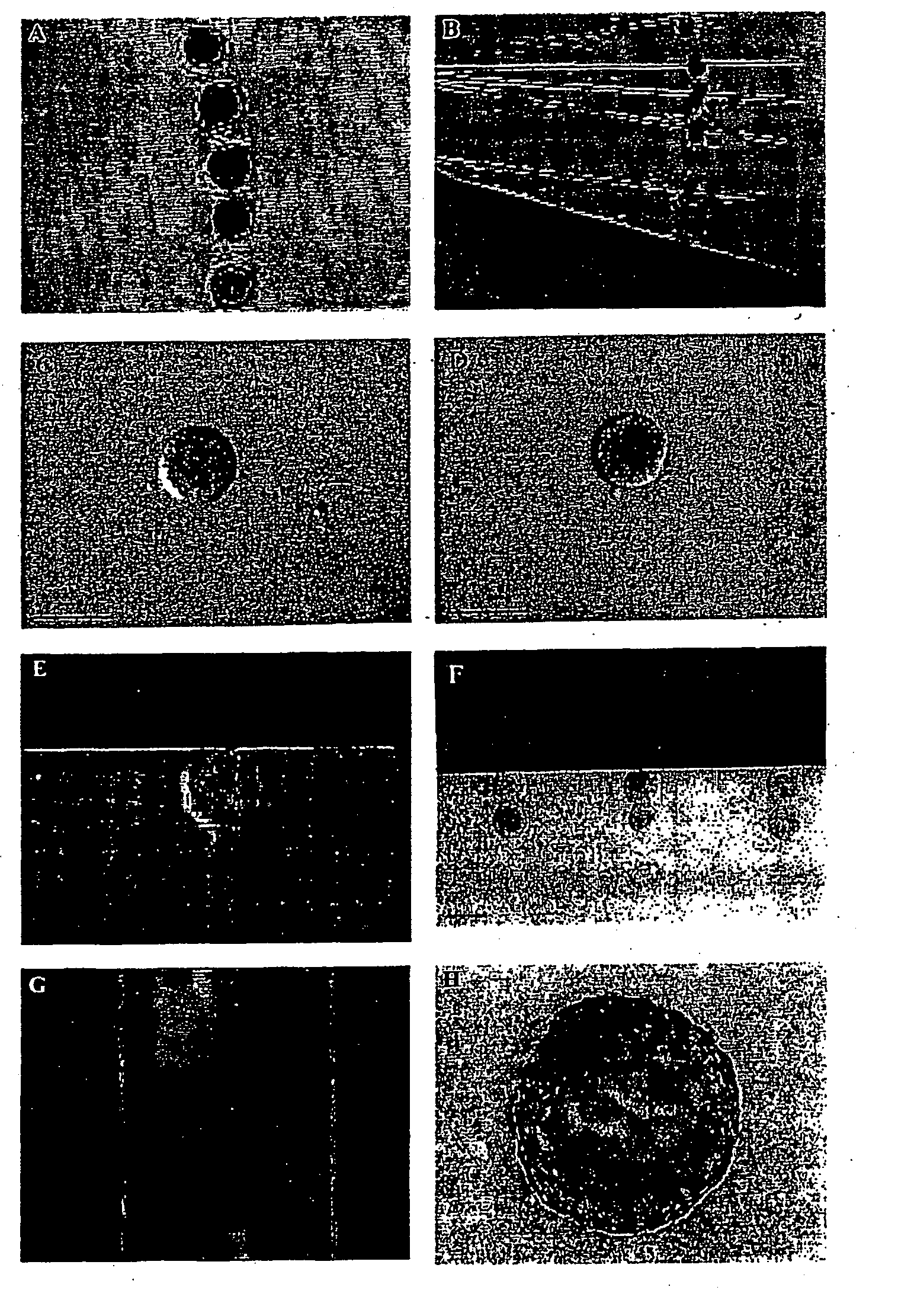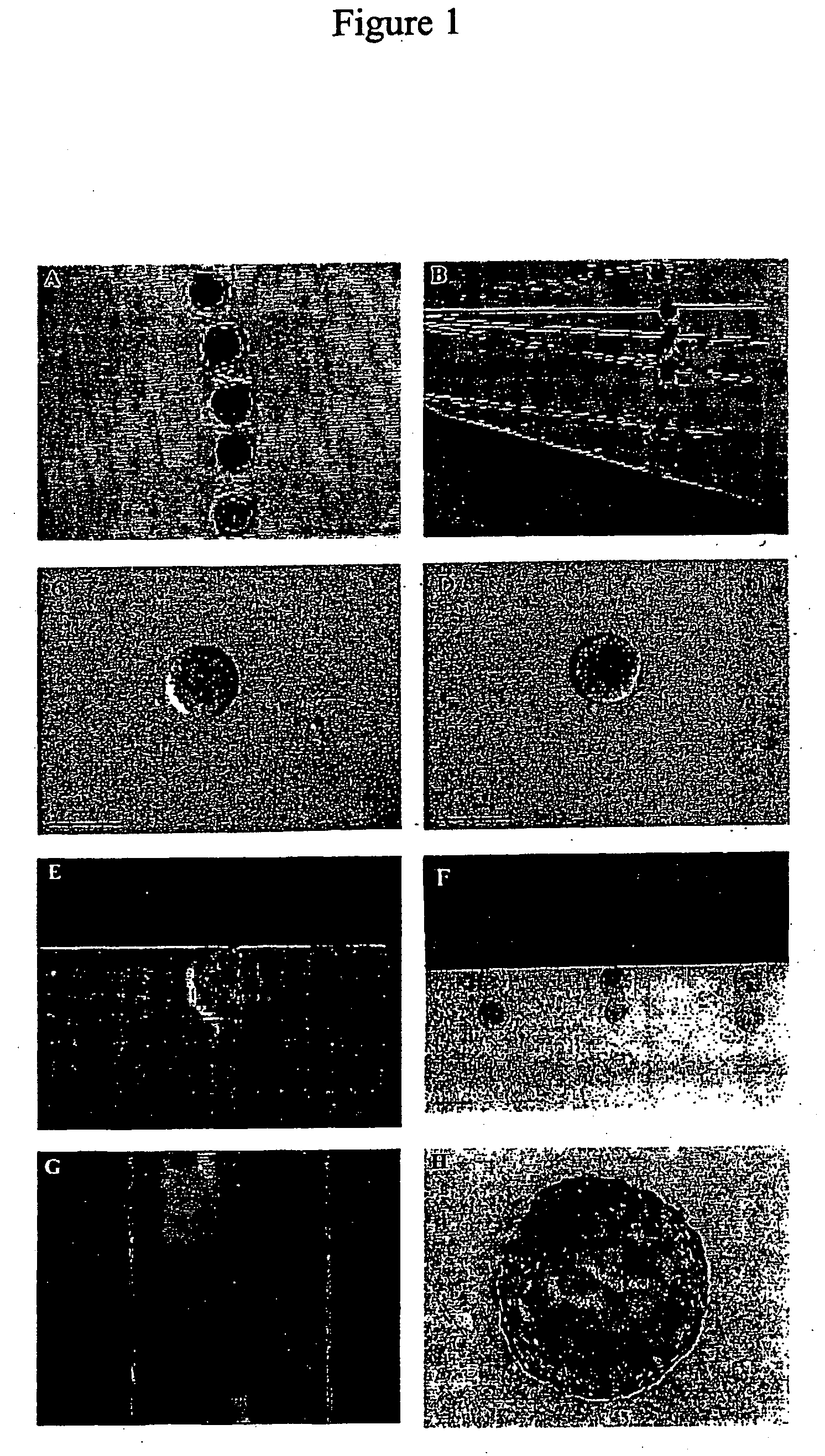Method of nuclear transfer
- Summary
- Abstract
- Description
- Claims
- Application Information
AI Technical Summary
Benefits of technology
Problems solved by technology
Method used
Image
Examples
example 1
Methods of Nuclear Transfer Using Granulosa Cells as Donors
[0143] Except where otherwise indicated all chemicals were obtained form Sigma Chemical Co. (St Louis, Mo., USA).
[0144] In vitro maturation of bovine oocytes (a total of 150 per day) was performed as described in detail earlier (Vajta et al., 1996) with minor modifications. Briefly, oocytes were aspirated from abattoir-derived ovaries, matured in 4-well dishes (Nunc, Roskilde, Denmark) for 24 h in bicarbonate buffered TCM-199 medium (Gibco BRL, Paisley, UK) supplemented with 15% cow serum, 10 IU / ml pregnant mare serum gonadotropin and 51 U / ml human chorionic gonadotropin (Suigonan® Vet, Intervet, Australia) and were incubated under mineral oil at 39° C. in 5% CO2 in humidified air.
[0145] At 19 h after the start of maturation cumulus cells were removed by vortexing. From this point (except where otherwise indicated) all manipulations were performed on a heated stage adjusted to 39° C. Mature oocytes (approximately 110) wer...
example 2
Results of Nuclear Transfer Using Granulosa Cells as Donors
[0155] The average efficiency of the main steps and the approximate time required in 7 replicate nuclear transfer experiments using a total of 1016 immature oocytes are summarised in Table 1.
TABLE 1AVERAGE EFFICIENCY AND APPROXIMATE REQUIRED TIMEFOR STEPS OF ZONA-FREE SOMATIC CELL NUCLEARTRANSFERIndividualCumulativeTimeProcedureEfficiencyEfficiencyRequiredPB rate——30 mindeterminationZona removal99%99%10 minBisection89%88%20 minUV investigation91%80%30 minFirst fusion94%75%40 minSecond fusion91%69%15 min(Related work)——35 minTotal180 min
[0156] Oocytes without a well visible polar body (28% of the total) were discarded. However, this loss cannot be attributed to the nuclear transfer method itself; therefore these were not included in the calculation of efficiency. The losses during bisection are the result of lysis observed 5 min after the completion of the procedure. The final accuracy of enucleated oocyte selection was c...
example 3
Simplified Zona-Free Somatic Cell Cloning Techniques
[0162] The protocols used in this Example were the same as those described in Example 1, with the following exception.
[0163] Reconstituted nuclear transfer embryos were either cultured singly, or as aggregates of 2 reconstituted nuclear transfer embryos and culture was performed either in glass capillaries or in the WOWs, in 4 well Nunclone dishes. After activation the embryos were drawn into the glass tubes or placed into the WOW depressions, either individually, or alternatively, 2 “reconstituted” nuclear transfer embryos were cultured in each glass capillary, or in each WOW depression, and cultured as aggregates after activation.
[0164] Tables 3, 4 and 5 show the blastocyst development rates and pregnancy rates from the culture and a transfer of nuclear transfer embryos produced using the techniques described in Example 1. The reconstituted nuclear transfer embryos were cultured either individually (Table 3) or as aggregates o...
PUM
| Property | Measurement | Unit |
|---|---|---|
| Fraction | aaaaa | aaaaa |
| Fraction | aaaaa | aaaaa |
| Fraction | aaaaa | aaaaa |
Abstract
Description
Claims
Application Information
 Login to View More
Login to View More - R&D
- Intellectual Property
- Life Sciences
- Materials
- Tech Scout
- Unparalleled Data Quality
- Higher Quality Content
- 60% Fewer Hallucinations
Browse by: Latest US Patents, China's latest patents, Technical Efficacy Thesaurus, Application Domain, Technology Topic, Popular Technical Reports.
© 2025 PatSnap. All rights reserved.Legal|Privacy policy|Modern Slavery Act Transparency Statement|Sitemap|About US| Contact US: help@patsnap.com


